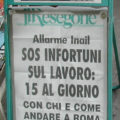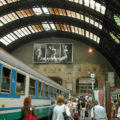I called Enrico in New Haven to let him know the news. He had not been happy about my traipsing off to Africa in the first place, so, while he was happy that I was pregnant, he was not at all happy that I was pregnant in Africa, and wanted me to come home immediately.
This was around week two of a four-week working trip, and I still hadn’t managed to accomplish much of the work I had been sent to do in Tanzania. I was reluctant to walk away from the project, even though I was not feeling at all well. The next morning the center shuttle van came to pick me up, and I vomited in the van. The kind driver was very concerned – he thought I had gotten malaria. I didn’t want to tell anybody at the center that I was pregnant. I knew that being pregnant and not (yet) married wouldn’t have been a big deal in Cameroon, but I wasn’t sure how Tanzanian culture would react.
Enrico left no stone unturned in trying to persuade me to drop everything and fly home. He called my parents and every friend of mine he could find a number for – between that and frequent calls to me in Tanzania, his phone bill was around $800 that month. As a result, I got calls from everyone. My parents, to my surprise, switched tracks – Mom said she didn’t feel old enough to be a grandmother, while Dad was clearly delighted at the prospect of being a granddad. My friend Stephanie, who had never even spoken to Enrico before, called in some bemusement – she had had a frantic call from him, begging her to convince me to come home.
Meanwhile, I tried to find something in Tanzania that I could stand to eat. It seems petty to say so, but the food in Arusha left a lot to be desired; I had been sorely disappointed after the wonderful cuisine of Cameroon. In desperation, I switched hotels, to the new Swisshotel across town. The hotel chain had sent a chef out from Switzerland to teach the local staff how to cook the hotel’s standard menu. Sitting in the dining room one day, I was witness to an amusing scene:
The chef was describing the menu, item by item. The steak sandwich, he explained, was a steak on a long, crusty baguette. He illustrated a long shape with his hands.
“No, no, sir,” said the Tanzanian cooks, “a sandwich is like this!”- and their hands shaped a standard American square of bread.
[Some Tanzanians have by now learned to make long sandwiches: my classmate Mahmood opened Africa’s first Subway franchise several years ago, in Dar-es-Salaam.]
The only foods I could keep down were tomatoes and salted peanuts. On my aunt Rosie’s advice, I also drank lots of Coke – she told me that Coke syrup used to be sold in pharmacies in the States as a remedy for morning sickness. It works, for morning sickness and any other form of nausea.
Between starvation, Enrico’s badgering, and frustration with the training project that was not getting accomplished, I finally decided to leave Tanzania a week earlier than scheduled, and fly to Rome to join Enrico and his family for Christmas (as originally planned). My boss wasn’t best pleased about it – “You always give the client more than you promised, not less!” Well, neither the client nor I had reckoned on me turning up pregnant…
Getting out of Tanzania involved a bit of adventure. The American woman with whom I had travelled to Ngorongoro (I’ll call her Donna) was working out in the bush on an ostrich-rescue project. Ostriches are extremely stupid; they don’t look after their nests, so the survival rate from egg to adulthood is about ten percent. Donna and her partners had a deal with the Tanzanian wildlife service whereby they would go out and collect the wild eggs, and hatch them in incubators on a farm. They would take some percentage of the chicks to ostrich farms in the US, and release older chicks back into the wild, with a greatly enhanced survival rate, resulting in a net gain in Tanzania’s ostrich population.
Donna and I had become friends; she’d come in from the bush every few days and borrow my hotel room to luxuriate in a hot shower. She planned to go back to the States soon, so I scheduled my departure to coincide with hers. There aren’t that many flights out of Arusha; we both booked on flights out of Nairobi, Kenya, which meant a few hours’ trip by jeep, across an international border.
A few days before we were to leave, Donna left a note in my hotel room: “See you soon! And I’m bringing a surprise!” Uh oh. No, she couldn’t, really – could she?
She did. She brought a baby ostrich.
The ostrich chicks bound for the US were shipped several dozen to a large crate, high enough for them to stand up in (at several weeks old, they’re about two feet tall). And they did stand up for the whole trip – anybody who sat down would get trampled and suffocated. This particular chick had a bad leg and couldn’t stand up properly; his chances of surviving the trip, let alone in the wild, were very slim.
Donna knew someone at the San Diego wildlife park who could perform the surgery little Gimpy needed to stand and run and live a normal ostrich life; the problem was to get him to San Diego. Her permit did not allow her to export ostriches except by the crateful, so she decided to smuggle him with her on the plane.
The first step was to cross the land border between Tanzania and Kenya, where passports, and possibly luggage, would be inspected. Donna put the ostrich in a gym bag which she stuffed down behind the car seat, out of sight of the driver, leaving just a hole open for his head to stick out. When we reached the border, she stuffed his head into the bag and casually tossed a jacket over it; our luggage was not checked, and we breezed on through.
Our flights from Nairobi were in the evening, many hours after our arrival, so we had booked a hotel room for the day. I didn’t feel well enough to do anything but rest, so I stayed in the room with the ostrich while Donna went out shopping. She put him on the floor near the bed, on a towel, and gave him salad and water. I lay down for a nap.
I had not known that ostriches make noise – but only when they’re happy. The jeep trip had been bumpy and traumatic, so Gimpy had stayed quiet. Now he started burbling with contentment, a soft warbling noise. I sat up in bed, startled, and looked at him. He looked at me. I lay down again. He started warbling again. I didn’t get much sleep, but, on the other hand, how many times in life do you get to hear an ostrich sing?
Getting Gimpy through Nairobi airport was going to be a little trickier. Donna took a hotel pillowcase and cut holes near the open end so that she could wear it over her arm like a shoulder bag. She put Gimpy in that, so he was snugged between her elbow and her waist, but he made too bulky a package to hide under her bush jacket. I loaned her my beloved Indian shawl, the dull brown one I had bought on a special occasion years before. Loads of sentimental value – I would not have risked it for anything less than saving the life of an ostrich. Donna draped the shawl casually over her shoulder; it looked completely natural while covering the pillow case and the ostrich.
My flight was earlier, so we went to the airport separately. I got worried for Donna when I saw that body scans and pat-downs were being performed on all passengers, and hand luggage was being x-rayed. How was she going to manage?
I got the whole story from her later, when we spoke on the phone after we had both returned to the US. Donna told me she had surveyed the security situation, and saw that she would have a problem with the body check. But she also noticed that the people manning the x-ray scanners were scarcely looking at their monitors. So she stuffed Gimpy back into the gym bag, under some other things, and he went through undetected (makes you feel good about Nairobi security, doesn’t it?). She said that, on the plane, the problem was to keep him from getting happy and making noise; she kept having to kick him. At Heathrow airport, she bought some salad and went into a breast-feeding stall in the women’s bathroom to feed him (he had to be more or less force-fed). A lady came into the bathroom with a baby, looked into the open stall, blanched, and quickly left.
Donna somehow got the ostrich all the way to California, where surgery was successfully performed, and Gimpy presumably lived out the rest of his days happily at the San Diego wildlife park. She mailed my shawl back to me, and now it’s had one more adventure than I have, having been an active participant in the great ostrich smuggling caper.
- The Italian Proposal
- Tanzania Surprise
- Coca-Cola, and an Ostrich
- Justice of the Peace


























